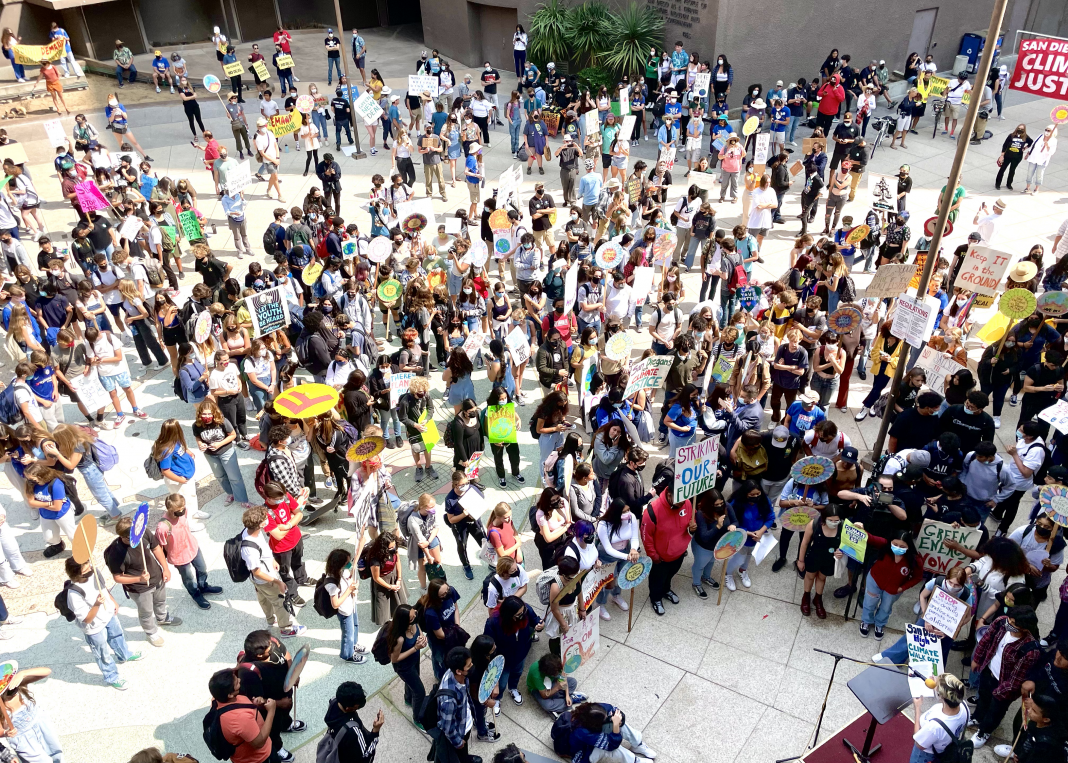It was a sunny and warm spring day on the San Diego Bayfront. Kids were running on the playground. People enjoying the outdoor restaurants. Friends on the grassy area hanging out. As a group of us were waiting on the lawn in front of the administration building on this beautiful Friday afternoon, you couldn’t help but feel a sense of urgency, intensity and excitement. As we knew what was coming and what we had planned for was about to come to fruition. Just a few minutes before the clock struck 3pm we could hear the faint sound of voices chanting. That sound grew louder and louder. The crowd grew larger and larger until the roar of the climate strike arrived at its final destination. “STOP DENYING, THE EARTH IS DYING! STOP DENYING, THE EARTH IS DYING!” This was the chant, among many others, that was being amplified to make sure the message was heard loud and clear.
It’s global strikes like this that happened all around the world as a grand act of unity to show support for climate action. According to Fridays For Future, over 500,000 people from 93 countries across every continent joined in as part of the global climate strike on March 25, 2022. Attending a climate strike has become an effective and increasingly popular way for activists to make a difference and show their support.
We spoke with one of the strike organizers and member of the Youth Environmental Action Pod, Keala Minna-Choe, about what it meant for her to be involved. She said “This is an extremely important strike to be a part of. Not only are we mobilizing with youth across the globe, but we are all focusing on the strike’s theme: People Not Profit. I believe that this is a critical message that needs to be spread.” For too long companies have put their own profits above doing what is right for people and the environment, and it’s had extreme repercussions. Attending a global climate strike has allowed individuals to take physical action and let their voices be heard. When asked what she hopes people would take away from attending a climate strike, Keala said hope and urgency. She emphasized “I want to constantly convey the message that we as a society can fix our current climate crisis, but only if we join together!”
Fighting to protect our planet has brought people together from all walks of life. One thing that is certain is that the intensifying climate crisis will affect everyone in one way or another. Knowing this gives everyone involved a sense of togetherness. We also spoke with Matthew Cooney, the co-chair of the San Diego Climate Reality Project. He also emphasized community and hope and went on to share his insight on the strike. “Being part of a global climate strike really gives a sense of global comradery in the fight for the planet. Climate work can give a strange sense of invisibility – most people know at some level the trajectory that our planet is on, but with all the doom and gloom many choose to look away. Taking part in a global movement is a fantastic reminder that there is an international, intergenerational community of people fighting hard for our planet, and refusing to go unnoticed.”
The climate movement has been growing rapidly and unapologetically in recent years. We asked Matthew for his thoughts on the future and how this movement will evolve. “The climate movement is building serious momentum, and I think we have the younger generation to thank for that. They bring in fresh ideas and energy, and even at some astoundingly young ages they carry knowledge and drive that leave me humbled.” While speaking with Matthew he reminded us all that we are truly making a difference and that you will never regret being part of the solution.
As time goes on, activists are coming up with new ideas and strategies as to how to tackle this seemingly impossible endeavor. Over the past few weeks members of many activist organizations, known for their disruptive acts of civil disobedience, have taken bolder actions than ever. In addition to marching on to freeways and shutting them down and interrupting fashion events with large banners, many have super glued themselves to things like oil tankers, tables at town hall meetings or even an NBA basketball court so that they cannot be removed immediately without harm. In the week before Earth Day, the group Scientist Rebellion mobilized over 1,000 scientists all over the world to protest. In Los Angeles, NASA scientist Dr. Peter Kalmus handcuffed himself to the door of a Chase Bank and was later arrested. While at this event he gave an emotional speech to explain his actions. “I’m here because scientists are not being listened to. I’m willing to take a risk for this gorgeous planet. For my sons. And we’ve been trying to warn you guys for so many decades that we’re heading towards a f—–g catastrophe. And we end up being ignored, the scientists of the world are being ignored and it’s got to stop. We’re going to lose everything.” Chase Bank has contributed $382 billion in fossil fuel financing from 2016-2021, more than any other bank in the world. Whichever way you choose to be involved with the climate movement is up to you. Participate in a climate strike. Call your local politicians. Attend a webinar. Read a book on climate change. The most important thing is just to get started. Remember what’s at stake and what’s dependent on our success. Activism is a long and hard road but know that there is an ever-expanding mountain of support behind you. With unity and perseverance, anything is possible.

